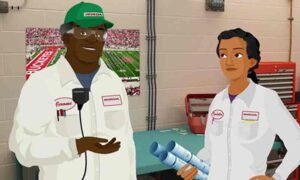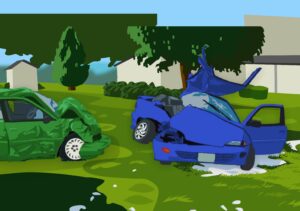Take on the role of the Surgeon throughout a total knee replacement surgery.
-
Anterior:
Closer to or at the front of the body. -
Anterior Cruciate Ligament (ACL):
The ligament that connects the tibia to the femur at the center of the knee. Its function is to limit rotation and forward motion of the tibia. -
Antibiotic Cement Spacer:
In the event a patient has a severe infection in the knee after a Total Knee Replacement, an antibiotic cement spacer will be placed in the knee (after the old prosthetics are removed) until the infection is healed and a new prosthetic can be inserted. The cement spacer is constructed of the same material as the cement used to hold the prosthetic components in place. -
Arthroscopy:
A minimally invasive surgery to repair or remove soft tissues of the knee, such as the Anterior Cruciate Ligament or the meniscus. -
Articular Cartilage:
The specific cartilage that covers the moving surfaces inside the knee such as the tibia and the femur, as well as the underside of the patella. -
Bone Spurs:
Abnormal projections of bone, also known as osteophytes. Usually caused by increased stress on the ends of the bones. -
Cartilage:
A smooth material that covers bone ends at a joint to cushion the bone and allow the joint to move easily without pain. -
Collateral Ligaments:
Ligaments that run along the sides of the knee and limit sideways motion. -
Condyle:
A rounded projection at the end of a bone that anchors muscle ligaments and articulates with adjacent bones. -
Femur:
The thigh bone or upper leg bone. -
Fibula:
The outer and thinner of the two bones of the human leg between the knee and the ankle. -
Glucosamine/Chondroitin:
Glocosamine is a dietary supplement that helps to grow and repair cartilage. Chondroitin helps cartilage maintain elasticity. -
Hamstring Muscles:
The muscle group located on the back of the thighs; they allow the knee to flex, the thigh to extend and the leg to be drawn inward. -
Hyaluronic Acid Injections:
Hyaluronic acid is found in the fluid in your joints and helps to protect them from wear. Osteoarthritis can cause the hyaluronic acid to get thinner, which means it doesn’t protect the joint as well. Injections can put more hyaluronic acid into your knee joint and help protect it more. -
Intramedullary Canal:
The canal that runs up the center of the femur. -
Lateral:
Farther from the midline of the body (near the side). -
Lateral Compartment:
The joint on the outer, or lateral side, of the knee. -
Long Bone X-ray:
A combination of three separate x-rays to produce one image of the legs. -
Ligaments:
Elastic bands of tissue that connect bone to bone. -
Malleoli:
Either of the two rounded protuberances on each side of the ankle, the inner formed by a projection of the tibia and the outer by a projection of the fibula. -
Medial:
Closer to the midline of the body (near the middle). -
Medial Compartment:
The joint on the inner, or medial, side of the knee. -
Medial Parapatellar Retinaculum:
The sleeve of tissue medial (midline) to the patella (kneecap). This is a continuation of the extensor mechanism (quadriceps and patellar tendon). -
Meniscus:
Pads of cartilage that further cushion a joint, acting as shock absorbers between two bones. Meniscus can be found on both the lateral (on the side) and medial (near the middle) side of the knee joint. -
Menisectomy:
Surgery that results in the removal of part of the meniscus, or cartilage, of the knee. This is typically performed arthroscopically, or through small holes instead of a large surgical incision. -
Osteoarthritis:
The most common type of arthritis affecting the knee. It is a chronic disease and is characterized by destruction of cartilage, overgrowth of bone, bone spur formation and impaired function. This type of arthritis occurs when bone rubs against bone and occurs in most people as they age. -
Osteophytes:
Abnormal projections of bone, also known as bone spurs. Usually caused by increased stress on the ends of the bones. -
Patella:
The kneecap; a flat triangular bone located at the front of the knee joint. -
Patella Femoral Arthritis:
Arthritis that is primarily focused around the kneecap (patella) and femur (thigh bone). -
Patellar Ligament:
This ligament helps secure the patella over the front of the knee joint. -
Patello Femoral Joint:
The joint under the kneecap, or patella. -
Primary Total Knee Replacement:
A “Primary” Total Knee Replacement refers to the first time a patient receives a knee replacement. The surgeon alters the femur, tibia and patella and fits those bones with prosthetic components. -
Post Traumatic Arthritis:
A sub-classification of osteoarthritis. -
Posterior:
Closer to or at the back of the body. -
Posterior Cruciate Ligament (PCL):
The ligament located just behind the anterior cruciate ligament. It limits the backward motion of the tibia. -
Prosthesis (plural is prostheses):
An artificial body part designed to supplement or replace natural parts. In total knee replacement, the prosthetic components replace the ends of the tibia and femur, the underside of the patella and compensate for cartilage and some ligaments. -
Pulse Oximeter:
A probe placed on a patient’s finger that measures the oxygen saturation level in his/her blood. -
Quadricep Muscles:
The muscle group located on the front of the thighs; they extend the legs. -
Resident, Orthopedic Resident:
After completing four years of medical school, doctors-in-training have a period of residency, or learning on the job. The residency can last from 4 to 7 years, and individuals at this stage of training are known as residents. -
Revision Surgery:
A surgery that replaces knee components or corrects problems from previous total knee replacement surgeries. -
Rheumatoid Arthritis:
An inflammatory disease that involves the lining of the joint (synovium). The inflammation generally affects the joints in the hands and feet and tends to occur equally on both sides. Over time, cartilage and bone becomes eroded and the joints become very deformed. -
Steroid Injections:
Injections of corticosteroid directly into the knee can often produce pain relief for those suffering from osteoarthritis. Corticosteriods reduce inflammation at the area of injection for days or weeks at a time. -
Synovial Membrane:
This membrane produces lubricating fluid (synovial fluid), which contributes to the smooth movement of the knee. -
Tendons:
Tough cords of tissue that connect muscles to bone. -
Tibia:
The shin bone or the larger bone of the lower leg. -
Valgus:
An abnormal position in which part of a limb is twisted outward away from the midline, opposite of varus. Also known as knock-knee. -
Varus:
An abnormal position in which part of a limb is twisted inward toward the midline, opposite of valgus. Also known as bowleg.









